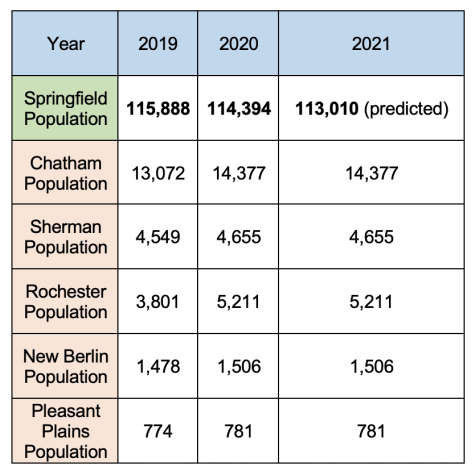BEYOND | Students Learn Better In-Person, but Remote Work May Still Have a Place in the Post-COVID World
Student participation seems to be up this semester due to the full reinstatement of in-person classes.
Though online learning had some perks, the chance to be in-person is a reminder to many of the benefits of face-to-face education.
Both learning and teaching from home require higher self-discipline and accountability. One Lincoln Land Community College professor said, “It’s hard enough in-person to get people to join in, let alone behind a computer screen.”
For students, the freedom and flexibility of online learning has made it more difficult to pay attention and get assignments done on time. It has proven to be more challenging for both students and teachers.
This fall, most colleges and universities are back in-person with alternative options to enroll in online or remote classes. For most, this ‘return to normal’ is a relief.
Professor Shelley Lewis of Lincoln Land Community College said: “When I’m in person, I feel like I can stop the assignment if it’s not going well, and redirect. And that may be confusing for kids, but it’s also beneficial, because if people obviously don’t seem to get it, or if it’s kind of falling flat on its face, I can stop and try to think of something else to do.”
For teachers, the concept of hybrid learning means twice the work. It becomes the instructor’s responsibility to replicate an in-person lecture in an online format for the students who choose to be remote. Because of this, teachers are left with very little room to change the speed or direction of lessons when necessary.
When classes were completely online, Lewis remembers her biggest struggle was persuading students to participate.
As a mother of high school and college students herself, Lewis remembers seeing her own kids struggle to stay awake through a Zoom lecture. Without face-to-face interaction with teachers as both an incentive and a resource, many students found it difficult to remain accountable to their schoolwork.
Isabella Pethy, a third-year transfer student at University of Illinois Springfield, was halfway through her first year of college when the pandemic sent students home in March of 2020.
At the time she was attending Webster University in Missouri. However, by the time the fall semester rolled back around, it did not make sense to pay higher tuition just to be stuck in online classes. This led her to transfer to UIS, but remote learning still came with its own set of challenges.
For Isabella, taking her classes online made it that much easier for her to procrastinate; she said, “In-person, I’m able to pay attention better but I also have no other option.”
This semester she is enrolled in one in-person class, one synchronous Zoom class and two online courses.
Online learning was a major change of pace for students, with its own set of benefits and consequences, but after the pandemic forced this way of life on her, Bella would, at this point, rather have all in-person classes.
While it is clear that working from home is not beneficial in schools, it appears to have opened more doors for businesses. Resource One, a Springfield-based company that deals and designs office furniture, had been in the process of developing a work-from-home program shortly before the pandemic began.
No one could have predicted the stay-at-home order back in 2020, but for the first time, it allowed schools and businesses explore the option to function under a hybrid model.
Resource One found that “having experienced both 100% in-office and at-home scenarios (and what seemed like everything in-between!), a personalized-hybrid model works best.” Before the pandemic, people were lucky if they could find a career that offered the luxury of working at home.
When asked which model his team prefers, Chris Davis says, “There are team members that still prefer to come in five days a week and there are folks whose particular health and/or family needs require more flexibility towards work from home.”
It appears that this hybrid work model will find its place in a ‘post COVID-19’ society and is here to stay.
With remote work now possible, a migration to smaller towns and rural areas has been seen.
“Overall, around one-in-five U.S. adults (22%) say they either changed their residence due to the pandemic or know someone who did,” according to a new Pew Research Center survey.
Many attributed their move to COVID and the fear of getting sick or the desire to be with loved ones. One respondent said they needed more space so they could work from home.
Central Illinois has not been immune to these changes. The Springfield population has gone down by over 1,000 each year since 2019 while the populations of surrounding small towns have increased. Now that most schools and businesses are moving back toward in-person work, people may also consider moving back into cities. It is also possible that this migration will continue and people will find that they prefer the middle of nowhere to a bustling and crowded life in a city.
Now that most schools and businesses are moving back toward in-person work, people may also consider moving back into cities. It is also possible that this migration will continue and people will find that they prefer the middle of nowhere to a bustling and crowded life in a city.
Without COVID, this lifestyle of living in smaller towns and working from home may not have been discovered.
Although most are enthusiastic for a full return to ‘normal’ someday, others will prefer to be hybrid forever. The long-term social effects of the pandemic may give them this option.
Abby Denney is a freshman at Lincoln Land Community College and an aspiring journalist. She plans to transfer to the University of Missouri to attend their journalism school with a minor in entrepreneurship. Abby is passionate about sustainable fashion and hopes to one day start her own magazine with a focus on sustainability. She spends her free time thrift shopping and playing the guitar.











